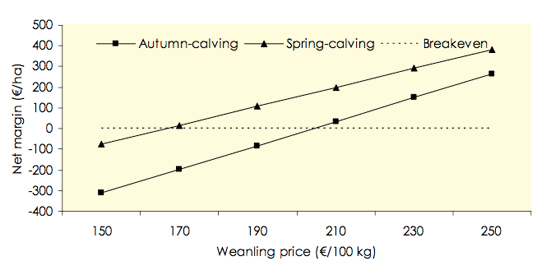



Suckler Beef Production In Ireland: Calving Date
Research by Paul Crosson and Mark McGee, at Teagasc Animal & Grassland Research and Innovation Centre focuses on profitability for suckler beef production. This section looks at the importance of calving dates.Calving date
Suckler beef production in Ireland is predominantly based on spring-calving cows with 70 per cent of calvings between January and May. However, there continues to be an interest in autumn-calving systems. A key motivation for autumn-calving in many cases is to provide weanlings for the premium priced, live export market.
This market requires E and U grade weanlings and in this respect, autumn-calving systems facilitate greater use of AI as cows are indoors during the breeding season, thus providing for increased sire selectivity and higher quality (muscularity and weight for age) progeny. Autumn-born weanlings are also available for sale earlier in the season and can therefore, avoid the peak weanling supply period in late autumn.
Where sale is delayed until this peak supply period, sale live weight is greater and hence, weanling/yearling value is also greater. Where a split-calving pattern is operated, i.e. calving a proportion of the cow-herd in spring and the remainder in autumn, a further advantage is that labour requirements are not concentrated into a single period. However, autumn-calving systems are associated with higher costs relative to spring-calving systems.
Firstly, feed costs are typically greater because the cow is lactating during the winter indoor feeding period and requires higher quality (more expensive) silage and/or concentrate supplementation.
Secondly, housing/facility costs are greater as additional creep areas for calves are required. Figure 1 illustrates the impact of calving season on net farm margin for suckler calf-to-weanling systems.
Three results are apparent: 1) Spring-calving systems are more profitable at all weanling prices. 2) The profitability of autumn-calving systems increase at a greater rate as weanling price increases. In essence, the additional weanling price is captured to a greater degree by the additional liveweight output from autumn-calving systems. 3) A weanling price of €167/100 kg and €204/100 kg is required to breakeven in spring- and autumn-calving systems, respectively.
Figure 1. Impact of calving date on net farm margin for suckler calf-to-weanling production systems

For spring-calving systems the date of calving is also of interest i.e. what is the optimum spring-calving date. If mean calving date is too early, i.e. prior to the start of the grazing season, lactating suckler cows will require supplementary feeding and/or higher digestibility (more expensive) grass silage.
Conversely, if calving date is delayed until after the grazing season begins, the economic advantage of early spring grazing will not be captured i.e. dry, pregnant cows will remain indoors on more expensive grass silage despite the availability of cheaper grazed grass. Research at Grange has shown that delaying calving date by three weeks or six week reduced profitability by nine per cent and 19 per cent, respectively (Figure 2).
This equates to a reduction in profitability of €1.41/cow for each day that calving date is delayed. In this analysis, no performance effect of turnout date is assumed and therefore, the effects are due to differences in feed costs and slurry handling costs.
Figure 2. Impact of calving date on net farm margin for suckler calf-to-beef production systems



